 |
 |
 |
| |
Prevalence of Cervical Cancer Screening Among HIV-Infected Women in the United States: 23% Did Not Receive Pap tests within last year
|
| |
| |
Reported by Jules Levin
CROI Feb 8-12 2009
Alexandra M. Oster, MD,1,2 Patrick S. Sullivan, DVM, PhD,2,3 Janet M. Blair, PhD, MPH2 1 Epidemic Intelligence Service, Office of Workforce and Career Development, Centers for Disease Control and Prevention, Atlanta, GA 2 Division of HIV/AIDS Prevention, National Center for HIV/AIDS, Viral Hepatitis, STD, and TB Prevention, Centers for Disease Control and Prevention, Atlanta, GA 3 Department of Epidemiology, Emory University Rollins School of Public Health, Atlanta, GA
ABSTRACT
Background: Approximately 250,000 women in the United States are HIV-infected. An estimated 13 to 60% of these women have cervical cytological abnormalities, which can lead to invasive cervical cancer. HIV treatment guidelines recommend initial and annual Pap tests for all HIV-infected women. We assessed screening prevalence and associated factors among HIV-infected women to determine whether Pap screening is performed as recommended.
Methods: We used data collected during 2000 to 2004 in the Supplement to HIV/AIDS Surveillance project, a cross-sectional interview study of HIV-infected persons aged ≥18 years in 18 states. Variables included demographic/socioeconomic factors, gynecologic history, HIV care, and use of medical services. We performed logistic regression to compute adjusted odds ratios (AOR) and 95% confidence intervals (CI) for the association between various factors and not having a Pap test.
Results: Among 2417 women, 556 (23.0%) had not had a Pap test during the past year. Factors associated with not having a Pap test included increasing age (AOR = 1.3/10 years, CI 1.1 to 1.4) and most recent CD4 cell count of <200 (AOR 1.6, CI 1.1 to 2.1) or unknown (AOR 1.4, CI 1.1 to 1.7). Compared with women whose most recent pelvic exam was performed at their HIV care provider's office, those whose pelvic exam was performed elsewhere had increased odds of not having a Pap test during the past year (AOR 2.6, CI 2.1 to 3.2). Educational level, household income, drug use, and insurance status were not significantly associated with Pap screening.
Conclusions: HIV care providers should ensure that annual Pap tests are performed for women of all ages who have low CD4 cell counts or receive gynecologic care elsewhere. Integrating HIV and gynecologic care and educating clinicians about Pap screening recommendations for HIV-infected women may increase screening among this population.
AUTHOR DISCUSSION
One-quarter of HIV-infected women had not received the recommended Pap test during the past year
Three factors were associated with not receiving a Pap test:
1. Last pelvic exam at location other than usual source of HIV care
-Requires additional coordination from physician and patient
-Effect particularly notable for Hispanic women
2. Increasing age
-Other competing health issues shift focus from cervical cancer prevention
-Unlike HIV-negative women, screening should continue indefinitely
3. CD4 count < 200
-Increased risk of other illnesses lead to competing priorities
-At higher risk of abnormalities
-Cervical cancer screening should be a priority
BACKGROUND
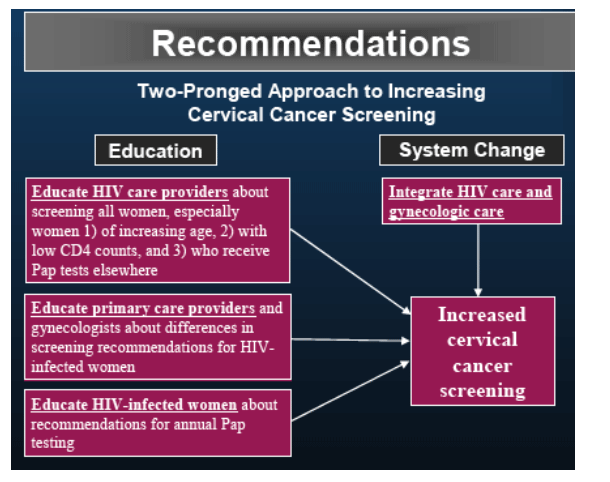
HIV-infected women are predisposed to cervical disease
-- 13-60% of HIV-infected women have cervical cytological abnormalities, which
can lead to invasive cervical cancer
-- Women with low CD4 counts are at particular risk
HIV-infected women should receive regular cervical cancer screening
-- HIV treatment guidelines recommend that providers:
-Include Pap test as part of initial evaluation
-Repeat once during first year after diagnosis
-Repeat annually thereafter
OBJECTIVES
Determine whether cervical cancer screening is performed as recommended
Determine factors associated with not receiving cervical cancer screening
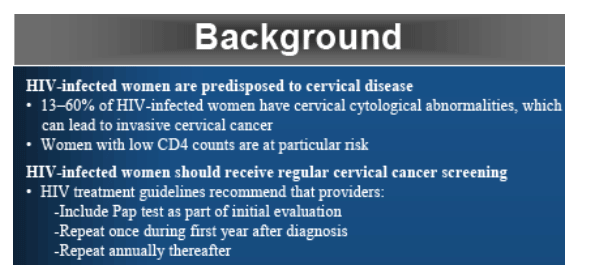
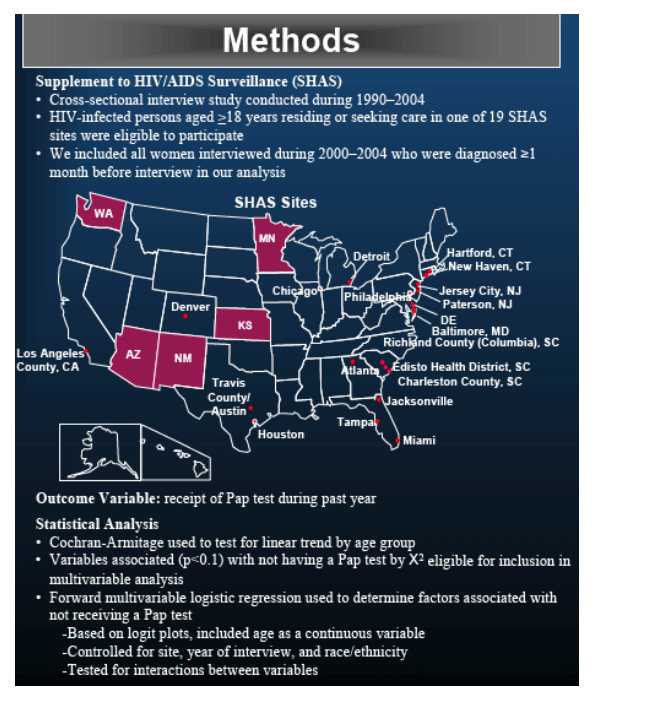
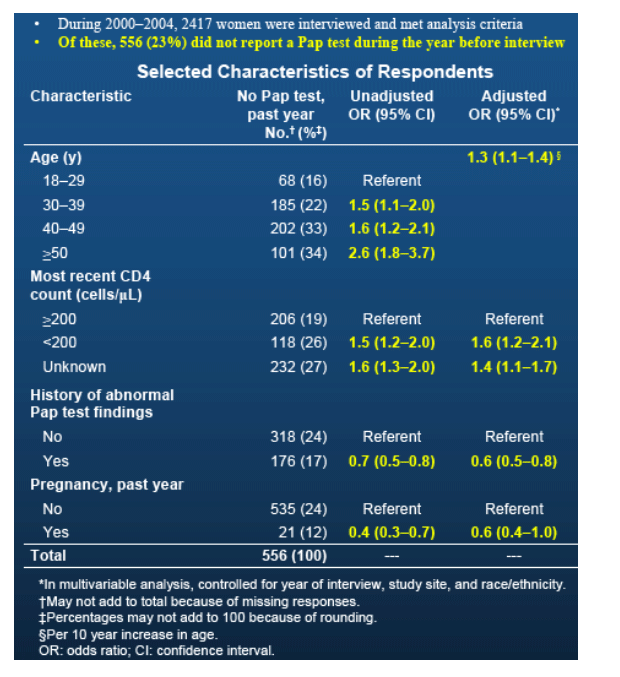
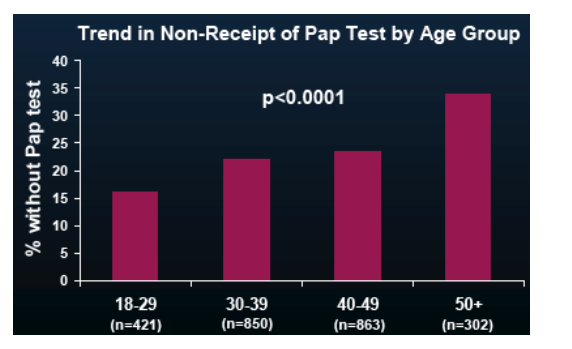
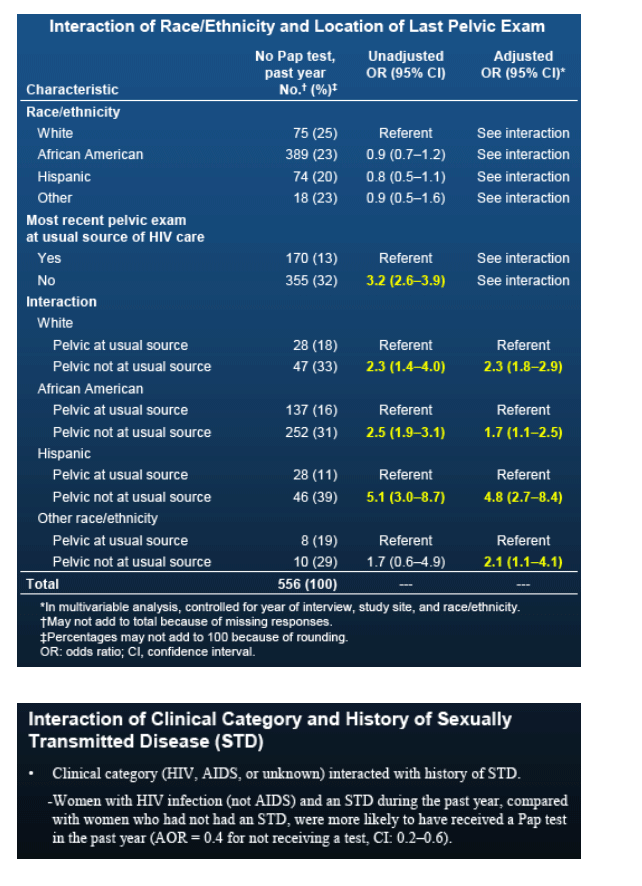

|
| |
|
 |
 |
|
|